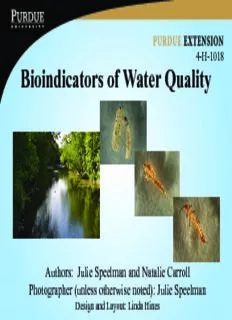
Aquatic Insect flashcards PDF
Preview Aquatic Insect flashcards
4-H-1018 Bioindicators of Water Quality Authors: Julie Speelman and Natalie Carroll Photographer (unless otherwise noted): Julie Speelman Design and Layout: Linda Hines Aquatic insects can be used as bioindicators of water quality. These bioindicator cards show larval stages of aquatic insects that may be found in Indiana waterways and a corresponding tolerance score. The tolerance score represents the insect’s sensitivity to pollution and is used to estimate water quality. Insects with a tolerance score value of 0 are intolerant to pollution, while insects with a tolerance score of 10 are very tolerant of pollution. More complete instructions and data sheets are available at: www.four-h.purdue.edu/natural_resources/ (select “Resources for Teachers” and “Bioindicators”) Instructions: • Take samples from all stream habitats along a Materials Needed: 200-foot section. dip net • Collect insects for 45 minutes. Captured insects should plastic bowl be placed in container with stream water. or dishpan • Sort the insects that look the same into different egg carton compartments. • Use the bioindicator cards to identify the insects. a stream to sample • Record the number of insects from each insect family you identify on the data sheet. • Complete the calculations and determine the stream water quality rating. Assessing the water quality for your site: 1. Determine the Family Tolerance Score by multiplying the number of insects in each family by the tolerance value given for that family. 2. Determine the Order Totals by summing the number of insects and Family Tolerance Scores for each order. 3. Determine the Grand Total by summing the Order Totals (number of insects and Tolerance) 4. Determine the Biotic Index by dividing the Total tolerance score by the Total number of insects. 5. Estimate the stream water quality rating and degree of organic pollution from the Biotic Index table. Biotic Index Water Quality Rating Degree of Organic Pollution 0.00-3.75 Excellent Organic Pollution Unlikely 3.76-4.25 Very Good Slight Organic Pollution Possible 4.26-5.00 Good Some Organic Pollution Probable 5.01-5.75 Fair Fairly Substantial Pollution Likely 5.76-6.50 Fairly Poor Substantial Pollution Likely 6.51-7.25 Poor Very Substantial Pollution Likely 7.26-10.0 Very Poor Severe Organic Pollution Likely Ephemeroptera Mayflies Isonychiidae Common name: Brush-Legged Mayfly Occurrence: 16 species in North America Size: 8-17 mm Habitat: Riffle areas of streams and rivers on leaves and sticks Feeding group: Collectors/filterers Tolerance score: 2 (low) Polymitarcyidae Common name: Pale Burrowering Mayfly Occurrence: 7 species in North America Size: 12-35 mm Habitat: Silt- and clay-bottomed rivers, lakes, and streams Feeding group: Collectors/gatherers/filterers Tolerance score: 2 (low)
Description: